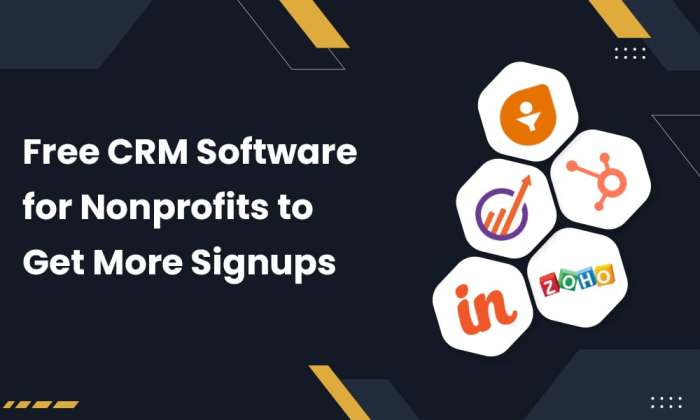Best CRM software for nonprofits and charities is crucial for efficient donor management and operational success. Nonprofits face unique challenges in managing relationships, tracking donations, and optimizing fundraising efforts. Selecting the right CRM system can significantly improve efficiency, streamline workflows, and ultimately, enhance the impact of their charitable work. This guide explores key features, top software options, and crucial considerations for nonprofits seeking to leverage technology for greater good.
This exploration delves into the essential features of a nonprofit CRM, including contact management, donation tracking, volunteer management, reporting and analytics, and crucial integrations with other vital software. We’ll compare leading CRM solutions, analyzing their strengths, weaknesses, pricing models, and suitability for different organizational sizes. Furthermore, we will address critical aspects like implementation, training, data security, and calculating the return on investment (ROI) of a CRM system.
Finally, we will touch upon emerging trends shaping the future of nonprofit CRM technology.
Defining Needs for Nonprofit CRM Software: Best CRM Software For Nonprofits And Charities

Nonprofits face unique challenges in managing donor relationships and operational efficiency. Limited resources, a reliance on volunteers, and the need to track complex interactions with diverse stakeholders often lead to fragmented data, inefficient workflows, and difficulty in demonstrating impact. A well-chosen CRM system can significantly alleviate these challenges by centralizing information, streamlining processes, and improving communication. Selecting the right CRM is crucial for long-term organizational sustainability and growth, enabling nonprofits to better serve their beneficiaries and achieve their missions.
A suitable CRM should offer features such as contact management, donation tracking, volunteer management, event management, and reporting and analytics capabilities. It should integrate seamlessly with other software used by the organization, and provide robust security features to protect sensitive donor data.
Key Features to Consider, Best CRM software for nonprofits and charities
Five essential features of a nonprofit CRM are crucial for success. These features contribute to improved efficiency, enhanced donor relationships, and better data-driven decision-making.
| Feature | Functionality | Benefit | Example |
|---|---|---|---|
| Contact Management | Centralized database for storing and managing donor information, including contact details, donation history, communication preferences, and volunteer activities. | Improved communication, personalized outreach, and enhanced donor relationships. | Storing all contact information for a major donor, including their preferred communication method and donation history, in one place. |
| Donation Tracking | Recording and tracking all donations, including the amount, date, method of payment, and associated fundraising campaigns. | Accurate financial reporting, improved fundraising strategy, and enhanced donor recognition. | Tracking a donor’s contributions over time, identifying their giving patterns, and thanking them for their support. |
| Volunteer Management | Managing volunteer recruitment, scheduling, training, and tracking volunteer hours. | Efficient volunteer coordination, improved volunteer satisfaction, and increased volunteer engagement. | Assigning volunteers to specific events or projects, tracking their hours, and recognizing their contributions. |
| Event Management | Planning, managing, and tracking events, including registration, ticketing, fundraising goals, and post-event analysis. | Improved event organization, increased fundraising efficiency, and better event outcomes. | Managing registrations for a fundraising gala, tracking ticket sales, and analyzing event participation. |
| Reporting and Analytics | Generating reports and dashboards to track key performance indicators (KPIs) such as donor acquisition, retention, and fundraising success. | Data-driven decision-making, improved fundraising strategies, and enhanced program evaluation. | Creating a report showing the number of new donors acquired in a given period, or analyzing the effectiveness of different fundraising campaigns. |
Integration with accounting software, email marketing platforms, and other relevant systems is essential for a seamless workflow and accurate data synchronization. Reporting and analytics dashboards provide valuable insights into donor behavior, fundraising effectiveness, and program impact, informing strategic decision-making and resource allocation.
Top CRM Software Options for Nonprofits

Several leading CRM platforms cater specifically to the needs of nonprofits, offering varying features, pricing models, and user capacity. Three prominent options are compared below to illustrate the range of choices available.
| CRM Name | Key Features | Pricing | Pros | Cons |
|---|---|---|---|---|
| Salesforce Nonprofit Cloud | Contact management, donation tracking, volunteer management, fundraising tools, reporting and analytics. | Variable, based on user needs and features. | Robust features, high scalability, strong security. | Steeper learning curve, higher cost compared to other options. |
| DonorPerfect | Donation tracking, fundraising management, grant management, reporting and analytics, specifically designed for nonprofits. | Subscription-based, various tiers available. | User-friendly interface, excellent for fundraising management, strong customer support. | May lack advanced features found in larger platforms. |
| Bloomerang | Donor management, fundraising tools, communication automation, reporting and analytics. Focuses on donor engagement. | Subscription-based, tiered pricing. | Intuitive interface, strong emphasis on donor relationships, excellent for smaller organizations. | Fewer features compared to more comprehensive CRMs. |
Implementation and Training Considerations
Implementing a new CRM system requires careful planning and execution to minimize disruption and ensure successful adoption. A phased approach, starting with a pilot program, is often recommended. Training is crucial for staff to effectively utilize the system’s features. This should include hands-on workshops, online tutorials, and ongoing support.
Strategies for minimizing disruption include providing adequate training, establishing clear communication channels, and securing buy-in from all staff members. A well-defined implementation plan, including timelines, responsibilities, and communication strategies, is essential.
Data Security and Privacy
Protecting sensitive donor data is paramount. Nonprofits must adhere to relevant regulations like GDPR and CCPA, and implement robust security measures to prevent data breaches and maintain donor trust. This includes encryption, access controls, regular security audits, and staff training on data protection best practices.
Examples of security measures include data encryption both in transit and at rest, multi-factor authentication, regular security audits, and employee training on data security protocols. Compliance with relevant data privacy regulations is critical.
Cost and Return on Investment (ROI)
The total cost of ownership for a CRM system includes software licenses, implementation costs, training, and ongoing maintenance. Calculating ROI requires considering both tangible and intangible benefits. Tangible benefits include improved efficiency, reduced administrative costs, and increased fundraising revenue. Intangible benefits include enhanced donor relationships and improved program effectiveness.
For example, a nonprofit might calculate ROI by comparing the increased fundraising revenue generated through improved donor engagement with the cost of the CRM system. Reduced administrative time and improved efficiency also contribute to a positive ROI.
Future Trends in Nonprofit CRM
Several emerging trends are shaping the future of nonprofit CRM software. These trends are driven by technological advancements and the evolving needs of nonprofits.
- Increased use of AI and machine learning: AI-powered tools can automate tasks, personalize communication, and predict donor behavior, improving fundraising efficiency and donor engagement. For example, AI can analyze donor data to identify high-potential donors and personalize fundraising appeals.
- Greater emphasis on data integration and interoperability: Seamless integration with other systems, such as accounting and email marketing platforms, will become increasingly important for a holistic view of organizational operations. This allows for streamlined workflows and improved data accuracy.
- Mobile-first CRM solutions: As more staff and volunteers use mobile devices, CRM systems will need to offer responsive design and mobile-friendly interfaces for optimal accessibility and usability. This allows for real-time updates and data access from anywhere.
Ultimate Conclusion
Ultimately, choosing the best CRM software for your nonprofit involves careful consideration of your specific needs, budget, and long-term goals. By understanding the key features, evaluating different options, and planning for a smooth implementation, nonprofits can harness the power of CRM technology to improve operational efficiency, strengthen donor relationships, and maximize their impact on the communities they serve. Remember, a well-chosen and effectively implemented CRM system is not just a software solution; it’s a strategic investment in your organization’s future success.
FAQ Resource
What is the average cost of a nonprofit CRM?
Costs vary greatly depending on the features, number of users, and vendor. Expect a range from free (with limited features) to several thousand dollars annually for enterprise-level solutions.
How long does it typically take to implement a new CRM?
Implementation timeframes vary, but plan for several weeks to months, depending on the size of your organization and the complexity of the system.
What kind of training is needed for staff?
Comprehensive training is crucial. This usually includes initial onboarding sessions, ongoing support, and potentially specialized training for specific CRM functionalities.
Can a CRM integrate with my existing accounting software?
Many CRMs offer integrations with popular accounting software. Check for compatibility before selecting a system.
